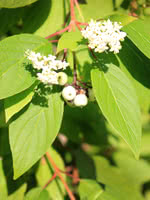Mon-Fri 9am - 5pm Mountain time
Yellow Twig Dogwood vs Western Snowberry
Cornus sericea flaviramea
Symphoricarpos occidentalis
CUSTOM GROW
NOT AVAILABLE THIS SEASON - MIGHT RETURN
Yellow Twig Dogwood is a small deciduous shrub with attractive, bright yellow bark.
It features delicate white, star-shaped flowers and white fruit. It is often used as a screen, and its wide-spreading roots help stabilize areas experiencing soil erosion.
Yellow Twig Dogwood complements Red Osier Dogwood, and it is a great filler to add winter color to shrub and flower gardens.
Like the Common Snowberry, the Western Snowberry is a small shrub with pink flowers useful for feeding livestock and preventing erosion. Unlike the common species, however, the Western Snowberry is much more suited to wet conditions, capable of persevering through poor soil drainage and occasional flooding.
After the Snowberry's flowers have bloomed, it produces berries which often last on the plant through winter. These berries are toxic to humans, but livestock and local wildlife love them! Those hoping to attract wildlife to their property can plant Snowberry and expect to see animals foraging on it much later in the year than other plants.
Yellow Twig Dogwood Quick Facts
Western Snowberry Quick Facts
Toxicity: berries are toxic to humans
In row spacing: 0.9 m (3 ft)

